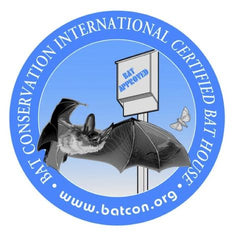BCI Certification Guidelines
Bat Conservation International (BCI) is an international non-governmental organization working to conserve the world's bats and their habitats through conservation, education and research efforts.
Many commercial bat houses are not suitable for North American bats because of inadequate design or construction, or they lack proper instructions concerning painting, placement, sun exposure and mounting.
BCI's Bat Approved Certification Program has worked since 1998 to improve the quality of bat houses and to provide some guidance for anyone interested in purchasing a bat house.
Our 1, 2, 3, and 4 chamber bat houses are certified by BCI.

Certification Criteria for Bat House Design and Construction
- Roost chambers must be a minimum of 20 inches tall. Taller is better.
- The width (side to side) of roost chambers must be at least 14 inches. Greater widths are preferred. Rocket style houses with continuous (360 degree) chambers are an exception. Depending on materials used, bat houses with roost chambers wider than 16 inches may require spacer blocks between partitions.
- Roost partitions must be carefully spaced 3/4 to 1 inch apart (front to back), regardless of the number of chambers. The best crevice size for most North American bats is 3/4 inch. Houses built specifically for larger species (pallid bats and Florida bonneted bats), with a combination of 3/4- and 1-inch chambers, may be acceptable, provided houses are advertised for those species. Advertising must also state that 1 1/2-inch chambers are more attractive to wasps and other non-target animals and require more frequent monitoring.
- Bat houses must include a suitable landing area. Either a three- to six-inch landing area must extend below the entrance (by extending the length of the backboard) or partitions must be recessed three to six inches so bats can land on the inside walls of the bottom of the bat house.
- Interior surfaces and landing areas must have adequate texture to provide footholds for bats. Rough-cut wood may suffice or surfaces can be mechanically grooved, roughened or scored horizontally at 1/4 to 1/2-inch intervals, approximately 1/16-inch deep. Roost surfaces can also be covered with a durable plastic mesh (we recommend 1/8- or 1/4-inch square mesh. Plastic mesh must be securely stapled every two inches (up, down and across) so it does not sag, buckle or curl. Mesh must not have sharp edges (trimming may be necessary). Metal mesh, hardware cloth or aluminum window screen is not acceptable, as these can injure bats.
- Screws, staples, nails, mounting hardware or other sharp objects (including splinters) must not protrude into roost chambers. All hardware and metal components must be exterior grade (coated, brass, galvanized, etc.). With few exceptions, all major components must be assembled with screws. Nails, brads or staples alone do not hold well over time. Any exposed metal edges (e.g. roofs) must be smooth.
- Half-inch tall ventilation slots must be provided and be placed no more than one-third the distance from the bottom. Front vents must be as long as a house is wide, and side vents (optional) should be approximately six inches tall by one inch wide. Decorative vents may be allowed, provided their size and position are adequate. Unvented wooden houses are acceptable if intended for cool climates only, which must be clearly stated in enclosed literature and advertising.
- Any plywood used must be exterior grade (e.g. ACX, T1-11, BCX). Boards should come from quality stock such as cedar or pine. Pressure- or chemically-treated wood must not be used, as they contain substances that may be harmful to bats.
- Overall construction must reflect that the bat house is a quality product. Bat houses must be durable and tightly constructed (no unplanned gaps). Caulking or gluing exterior joints (preferably during assembly) is required to prevent drafts. If not caulked or painted by the builder, adequate instructions must be provided for customers to caulk and paint the house. Latex caulk and exterior-grade, water-based paint or stain is recommended.
- Advertising and any instructions or literature included with bat houses must be approved by BCI. Unsubstantiated or misleading claims (e.g., "No more mosquito problems") will not be permitted. Instruction sheets included with bat houses must contain adequate information on painting, sun exposure, mounting height, mounting sites and recommended distances to water and obstacles.
